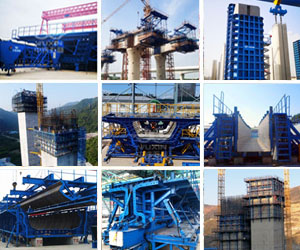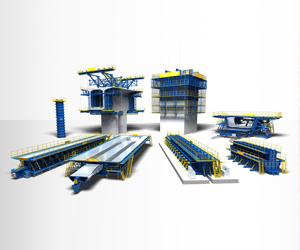Cast in situ bridge formwork
Cast-in-situ bridge formwork is a crucial component in bridge construction that plays a vital role in shaping and supporting the concrete during the casting process. Here is a detailed introduction:
Types of Cast-in-situ Bridge Formwork
Timber Formwork: It is made of wood planks and is relatively easy to shape and assemble. It has good surface finish and is suitable for small-scale projects or areas with complex shapes. However, it has a relatively short service life and is not as durable as other materials.
Steel Formwork: Composed of steel plates and steel frames, steel formwork is highly durable, has high strength and stiffness, and can withstand large pressures. It is suitable for large-scale bridge construction projects and can be reused many times, reducing costs in the long term. But it is heavier and requires more mechanical equipment for installation and removal.
Aluminum Alloy Formwork: Lighter than steel formwork, aluminum alloy formwork has good corrosion resistance and is easy to handle and assemble. It also has a high reuse rate and can improve construction efficiency. However, it is more expensive than steel and timber formwork.
Composite Formwork: This type combines the advantages of different materials, such as using a combination of steel and plastic or fiberglass. Composite formwork can have good durability, light weight, and excellent surface quality, and is designed to meet specific construction requirements.
Components of Cast-in-situ Bridge Formwork
Panel: The part that directly contacts the concrete, determining the shape and surface quality of the bridge structure. It needs to have good smoothness and strength to ensure the concrete surface is even and free of defects.
Support System: Consists of vertical supports, horizontal beams, and braces. It bears the weight of the concrete and the formwork itself, transferring the load to the foundation or the existing structure. The support system must be stable and strong enough to prevent deformation and collapse.
Connection Components: Such as bolts, nuts, and connectors, which are used to connect the panels and the support system together, ensuring the integrity and stability of the formwork.
Functions and Importance
Shaping Function: It precisely shapes the concrete according to the design requirements of the bridge, whether it is a beam, pier, or deck, ensuring the geometric accuracy and structural form of the bridge.
Support Function: During the pouring and curing process of the concrete, the formwork provides reliable support to prevent the concrete from deforming or collapsing due to its own weight and external forces.
Surface Quality Assurance: A good formwork surface can improve the surface quality of the concrete, reducing the need for post-construction surface treatment and improving the appearance and durability of the bridge.
Construction Process
Formwork Design: According to the bridge design drawings and construction requirements, the formwork is designed, including determining the type, size, and layout of the formwork, as well as calculating the strength, stiffness, and stability of the support system.
Installation: The formwork is transported to the construction site and assembled in accordance with the design requirements. The support system is first erected, and then the panels are installed and connected tightly.
Inspection and Adjustment: After the installation is completed, a comprehensive inspection is carried out to check the position, size, and stability of the formwork. Adjustments are made if there are any deviations to ensure that the formwork meets the construction standards.
Concrete Pouring: Concrete is poured into the formwork at a suitable speed and in a specified manner. During the pouring process, attention is paid to preventing the formwork from being deformed by the impact of the concrete.
Formwork Removal: After the concrete has reached the required strength, the formwork is removed in a certain order. The removal time needs to be determined according to the concrete strength test results to avoid damage to the concrete structure.
Cast-in-situ bridge formwork is an essential part of bridge construction, and its quality and construction technology directly affect the quality and safety of the bridge.









